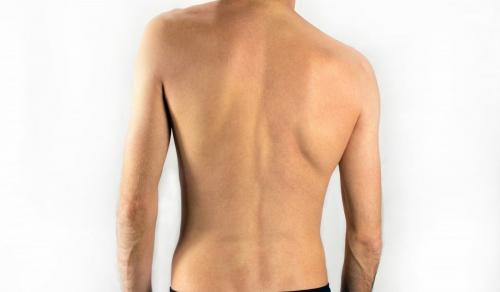Exercises for Scoliosis You Can Do at Home

Scoliosis is a condition in which the spine curves in an S or C shape. It is most common in childhood, but it can also occur in adulthood.
Adult scoliosis can be caused by several factors, including genetics, an uneven pelvic position, previous spinal or joint surgeries, knee or foot distortions, or even brain trauma.
Some curves are more difficult to navigate than others. Scoliosis can be treated with bracing or surgery in moderate to severe cases. If you think you might have scoliosis, talk to your doctor about a treatment plan.
Dr. Ratnav Ratan, a Gurgaon-based pediatric orthopedic doctor, explains that the difference between a normal spine and one with scoliosis is that the former can move from side to side. For example, when you walk, your spine bends and rotates left and right before returning to the center. Due to the curvature of their spine, people with scoliosis have difficulty moving in one direction.
The doctor would like to recommend some exercises to the patients in this article.
Three scoliosis exercises
The exercises below may or may not be tailored to your specific scoliosis diagnosis, but they are an excellent place to start to get you moving. These general strengths and conditioning techniques can sometimes be enough to alleviate mild scoliosis symptoms.
I. Step down and one-arm reach
1. Step onto a small box or step with the leg that seems longer when you lie on your back.
2. As you bend your knee, lower the opposing leg to the floor.
3. Raise the arm on the same side as the lowered leg as high as possible as you fall. Raise the left arm, for example, if the left foot is dropping to the floor.
4. Complete 2–3 sets of 5–10 repetitions on this side only. The exercise should not be done on the opposite side.
II. Upward and downward dog
1. Push your hips back and up as far as possible in a prone plank position with your arms stretched out straight.
2. Hold this position for 2 seconds before lowering your hips to the floor.
3. Try to get as low as possible without causing yourself any discomfort or pain in your back.
4. Do two to three sets of 5 to 10 reps.
III. Split stance with arm reach
1. Take a step forward with your longer leg in front of you and a slightly longer stride length.
2. Always keep your torso as upright as possible.
3. Begin shifting your weight back and forth, bending your front knee as you move your weight onto it.
4. Raise the arm opposite your front leg as high as possible while moving your weight forward.
5. While that arm is stretching upward, reach the other arm back as far as possible with the palm up. The torso and spine tilt to the side of the front leg as a result.
6. Only do this exercise on that side. 2 to 3 sets of 5 to 10 reps are recommended.
Schroth workouts
According to Gurgaon's orthopedic doctor for pediatrics, schroth exercises are asymmetric scoliosis-specific postural exercises that attempt to improve posture and pain while teaching patients to maintain the correct posture in daily activities consciously.
The abdomen, back, and leg muscles are targeted for endurance and strength training in these exercises.
According to a study, patients who completed schroth exercises improved their self-image, back muscular endurance, and pain levels.
Types of scoliosis
A physician or physical therapist may prescribe certain exercises to help you with your specific structural difference, but they are not a therapeutic option. Surgery will almost certainly be required to treat moderate to severe scoliosis.
Mild
Mild scoliosis does not usually necessitate medical care and is less noticeable than other postural issues.
Mild scoliosis is the phrase used to characterize scoliosis with a Cobb angle of fewer than 20 degrees or curvature of the spine. Exercise treatment is most effective for mild scoliosis.
Moderate
Exercise can help with moderate scoliosis, but a medically prescribed brace is occasionally recommended as well. Severe scoliosis, defined as a spine curvature of 40 to 45 degrees, can develop from moderate scoliosis.
Severe
Spinal surgery is frequently required to correct severe scoliosis.
Managing your scoliosis
According to Dr. Ratnav Ratan, one of the best pediatric orthopedic doctors in Gurgaon, mild scoliosis can often be controlled with exercise, medical supervision, scoliosis-specific physical therapy, and chiropractic treatment from a chiropractic scoliosis specialist. Yoga or pilates are also recommended for specific persons with scoliosis to reduce pain and develop flexibility.
Bracing is commonly used to prevent the spine from bending further in moderate scoliosis. Your doctor may propose greater medical surveillance or other treatment approaches depending on the curvature of your spine.
Surgery becomes the most suggested treatment option if the spine reaches a particularly advanced curvature and the person with scoliosis reaches a certain age. Scoliosis surgery can take numerous forms and is dependent on several factors, including:
• the way your spine is constructed
• the height of your person
• Whether or not the expansion of your spine has badly harmed other sections of your body.
Takeaway
Exercise is increasingly being advocated as a therapeutic option for mild to moderate scoliosis. You may be able to delay the curvature of your spine and reduce the discomfort you experience as a result of your scoliosis by being proactive and completing these exercises.
Pilates and yoga routines designed expressly for those with limited spinal flexibility can also help to relieve discomfort.
Before starting any scoliosis treatment program, even one that involves simple exercises, you should always consult with your orthopedist or physical therapist. This assures that practicing these exercises will not injure your skeletal system.
Post Your Ad Here
Comments